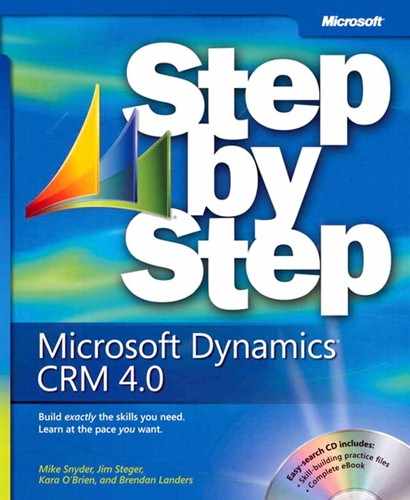Even with the sorting features in views, sometimes it can be time consuming to manually look for a particular record if the view contains a large number of records. To help address this concern, Microsoft Dynamics CRM includes a Quick Find feature that allows you to search for records by using keywords or wildcard characters. You can find the Quick Find search box above the grid and to the left of the View selector. To use it, enter a search phrase and press Enter on the keyboard or click the button with the magnifying glass to start the search. Even though Quick Find is simple to use, there are a few tips and tricks that will help you find records more efficiently.
Your system administrator can configure Microsoft Dynamics CRM to search for matching records across multiple columns. For example, you can search for particular contacts by name, phone number, or e-mail address. You can even include custom data fields as part of the search criteria.
When you enter search text, Microsoft Dynamics CRM searches for the value as it is entered. By default, it does not search for partial records. For example, if you search for a phone number by entering 555-1212 and the contact’s phone number is (312) 555-1212, Microsoft Dynamics CRM does not consider that a match. It returns only those records that have 555-1212 as the start of their phone number.
Of course, there will be times when you don’t know the exact value you’re searching for. In these cases, you can enter an asterisk (*) as a wildcard character in your Quick Find search. In the previous example, if you did not know the exact phone number, you could search for *555-1212 and Microsoft Dynamics CRM would find the matching record.
Tip
You can enter the wildcard character anywhere in your search criteria: at the beginning, the middle, or the end. If you can’t find the record you’re looking for, be sure to try different combinations with the wildcard asterisk. Note that the Quick Find feature is not case-sensitive in its searches.
If you start a Quick Find search when you’re working with a specific view, such as My Active Contacts, you might expect that Microsoft Dynamics CRM would search for matching records only within the My Active Contacts view. However, Quick Find always searches for matching records across all active records for that entity. Quick Find ignores inactive records.
Tip
To filter records within a specific view, you can click the letters in the index bar. Clicking a letter will update the view to show only those records whose entry in the current sort column starts with the selected letter. For example, if you’re looking at the My Active Contacts view with the records sorted by City and you click B in the index bar, Microsoft Dynamics CRM shows you only those records in which the city starts with the letter B. If you then click the Full Name column to sort by that field and click the letter C in the index bar, Microsoft Dynamics CRM updates the My Active Contacts view to show only those records in which the Full Name entry starts with the letter C.
In this exercise, you will use the Quick Find feature to search for records in Microsoft Dynamics CRM.
Note
BE SURE TO use the Internet Explorer Web browser to navigate to your Microsoft Dynamics CRM Web site, if necessary, before beginning this exercise.
OPEN a view of Contacts that contains more than one record.
In the Quick Find box, type *bi, and then press
 .
.Microsoft Dynamics CRM searches and returns all active contacts for matching records.
To cancel the search, click the Cancel Search button to the right of the Quick Find box, or simply select a new view in the view selector.

